

Low-Speed Aerodynamics > CHAPTER 6: Exact Solutions with Complex Variables > 6.6 Airfoil with Finite Trailing-Edge Angle - Pg. 137e. Conformal Mapping. Conformal mapping is a mathematical technique used to convert (or map) one mathematical problem and solution into another.
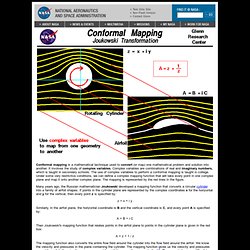
It involves the study of complex variables. Complex variables are combinations of real and imaginary numbers, which is taught in secondary schools. The use of complex variables to perform a conformal mapping is taught in college. Under some very restrictive conditions, we can define a complex mapping function that will take every point in one complex plane and map it onto another complex plane.
The mapping is represented by the red lines in the figure. Many years ago, the Russian mathematician Joukowski developed a mapping function that converts a circular cylinder into a family of airfoil shapes. Z = x + i y Similarly, in the airfoil plane, the horizontal coordinate is B and the vertical coordinate is C, and every point A is specified by: A = B + i C A = z + 1 / z Here is a Java simulator which solves for Joukowski's transformation.
Navigation .. What Airfoil Should I Use? There are two kinds of airfoils: Symmetrical and Semi-Symmetrical Symmetrical Airfoils NACA0006 to NACA0015These are known as NACA 4-digit airfoils where the 4 digit number defines the shape.
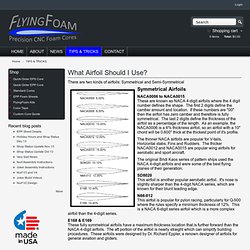
The first 2 digits define the camber amount and location. If these numbers are "00" then the airfoil has zero camber and therefore is fully symmetrical. The last 2 digits define the thickness of the airfoil as a percentage of the length. The thinner NACA airfoils are popular for V-tails, Horizontal stabs, Fins and Rudders. The original Bridi Kaos series of pattern ships used the NACA 4-digit airfoils and were some of the best flying planes of their generation. SD8020This airfoil is another popular aerobatic airfoil.
N66-012This airfoil is popular for pylon racing, particularly for Q-500 where the rules specify a minimum thickness of 12%. E168 & E169These fully symmetrical airfoils have a maximum thickness location that is further forward than the NACA 4-digit airfoils. Joukowsky transform. Example of a Joukowsky transform.
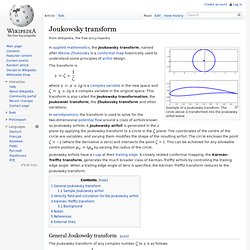
Airfoil. Examples of airfoils in nature and within various vehicles.
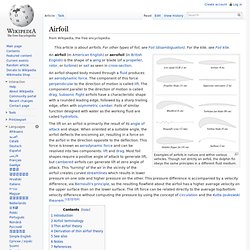
Though not strictly an airfoil, the dolphin fin obeys the same principles in a different fluid medium. Introduction[edit] Streamlines around a NACA 0012 airfoil at moderate angle of attack Lift and Drag curves for a typical airfoil Supersonic airfoils are much more angular in shape and can have a very sharp leading edge, which is very sensitive to angle of attack. A laminar flow wing has a maximum thickness in the middle camber line. Schemes have been devised to define airfoils — an example is the NACA system. Jef Raskin - Coanda Effect: Understanding Why Wings Work. MODEL AIRPLANES, THE BERNOULLI EQUATION, AND THE COANDA EFFECT © 1994 by Jef Raskin "In aerodynamics, theory is what makes the invisible plain.

Trying to fly an airplane without theory is like getting into a fistfight with a poltergeist. " --David Thornburg [1992]. "That we have written an equation does not remove from the flow of fluids its charm or mystery or its surprise. " --Richard Feynman [1964] A sound theoretical understanding of lift had been achieved within two decades of the Wright brothers' first flight (Prandtl's work was most influential1), but the most common explanation of lift seen in elementary texts and popular articles today is problematical. The common explanation, from The Way Things Work [Macaulay 1988] The reasoning--though incomplete--is based on the Bernoulli effect, which correctly correlates the increased speed with which air moves over a surface and the lowered air pressure measured at that surface.
Trefil's figure 11-4. In The Physics of Baseball, Robert K. 1. Gear. Two meshing gears transmitting rotational motion.
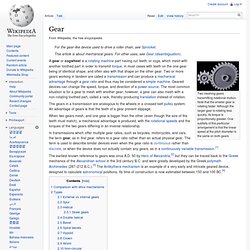
Note that the smaller gear is rotating faster. Although the larger gear is rotating less quickly, its torque is proportionally greater. One subtlety of this particular arrangement is that the linear speed at the pitch diameter is the same on both gears. The gears in a transmission are analogous to the wheels in a crossed belt pulley system. An advantage of gears is that the teeth of a gear prevent slippage. When two gears mesh, and one gear is bigger than the other (even though the size of the teeth must match), a mechanical advantage is produced, with the rotational speeds and the torques of the two gears differing in an inverse relationship.
In transmissions which offer multiple gear ratios, such as bicycles, motorcycles, and cars, the term gear, as in first gear, refers to a gear ratio rather than an actual physical gear. Comparison with drive mechanisms[edit] Types[edit] External vs internal gears[edit] Internal gear Spur[edit]